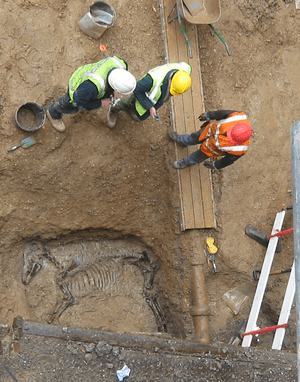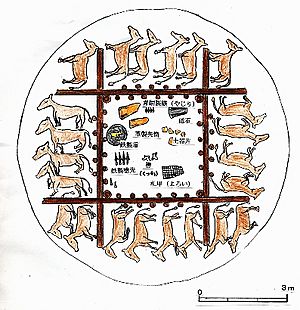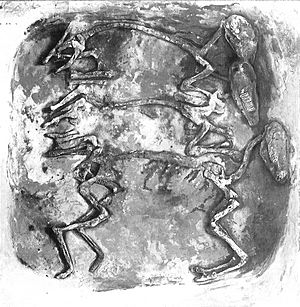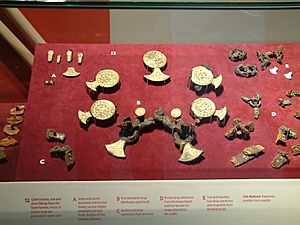Horse burial facts for kids
Horse burial is when people bury a horse as part of a human funeral. This practice was common among many groups, including people who spoke Indo-European languages, as well as Chinese and Turkic peoples. Burying horses shows how important these animals were to these cultures. It also helps us understand how people who loved horses moved around the world. It's rare to find other farm animals buried with humans. For example, in Britain, 31 horse burials have been found, but only one cow burial. Sometimes, a whole chariot was buried with a person, with or without a horse.
Contents
Why Horses Were Buried
Horses were very special in many cultures. For example, in Celtic and Germanic cultures, horses were sometimes linked to the sun's journey. People even thought horses could help them predict the future. While Celts rarely sacrificed horses, people in Germany and Scandinavia often buried horses with their dead. The widespread practice of horse sacrifice among Indo-European groups shows how important horses were.
Horse burials were not all the same, even in the same area. Sometimes horses were burned, and sometimes they were buried whole. They might be in the same grave as a human or in a separate pit. Some cultures buried horses mainly with male warriors, while others didn't seem to care about the person's gender.
Where and When Horse Burials Happened
Horse burial began where horses were first tamed. This was in the Eurasian Steppe around 4000–3500 BCE. Early cultures that buried horses lived in or near these areas. These include Turkic, Chinese, and Indo-European groups.
Some people think horse burial might go back to the Paleolithic Age. This idea comes from old finds where horse skins were hung over poles. But this is just one idea for what these ancient finds mean. The oldest proven horse burial is from the fifth or fourth millennium BC. It was found in S'ezzhee, Russia, by the Samara River.
Thousands of years later, the Greek historian Herodotus wrote about the Scythians burying horses. Usually, one or more horses were killed and buried with important leaders or warriors. In China, horse burials started in the Shang dynasty (1600–1100 BCE). These often included chariots.
In Kazakh culture, a dead person's horse was killed a year after its owner died. This happened during a ceremony with horse races. Horse burials continued among other groups more recently. For example, the Nez Perce people used stuffed horses as grave markers. The Blackfoot Confederacy also had similar traditions.
Sites with horse burials are found across areas where Indo-Aryan, Turkic, and Chinese people lived. These include:
- Tall al-Ajjul in the Gaza strip (around 2100 BCE).
- Central Iran, from the second millennium BC.
- Marlik in Iran (late second millennium BCE).
- Gordium in Phrygia (possibly after 700 BCE).
A horse burial in Bactria shows that horse cultures moved from Central Asia to Turkmenistan in the second millennium BCE. A burial in Tell el-Dab'a, Egypt, shows that the Hyksos brought horses to Egypt. This happened during the Second Intermediate Period of Egypt (1650–1550 BCE).
Around 700 BCE, a nomad's burial mound (called a kurgan) was found at Kostromskaya in southern Russia. It had the main male body, thirteen other humans, and twenty-two horses buried in pairs around the edges. Lavishly decorated horses were also killed and buried in the Pazyryk burials. These horses were sometimes in separate rooms from the human remains.
Horse burials were common in pre-Christian Hungary in the 9th and 10th centuries. Especially rich people were buried next to the skin and skull of a saddled horse. The rest of the horse meat might have been eaten during the funeral. Roman culture also left horse burials across their empire. These include first-century burials in modern-day Waremme, Belgium, and Beuningen, Netherlands.
Germanic Cultures
Germanic peoples thought horses were very important. Horses might have been friends of the god Wodan. Some even believed horses shared secrets with the gods. Old Scandinavian writings from the 8th to 11th centuries show how important horses were to Viking society. Horses were closely linked to gods like Odin and Freyr. They played a big part in funerals and other special events. Horses were also symbols of good harvests and new life. Rituals included horse fights, burials, eating horse meat, and horse sacrifice.
Hengist and Horsa, the legendary ancestors of the Anglo-Saxons, were connected to horses. Horses are mentioned often in Anglo-Saxon stories. Actual horse burials in England are quite rare. They might show influence from other parts of Europe. A famous Anglo-Saxon horse burial (from the 6th or 7th century) is Mound 17 at Sutton Hoo. This is near the more famous ship burial in Mound 1. A 6th-century grave near Lakenheath, Suffolk, had a man's body next to a "complete horse in harness, with a bucket of food by its head." Another important example is the Wulfsen horse burial from 700–800 CE, near Hamburg, Germany.
Horse burials are common in Iceland. By 1999, 115 graves with horse remains were found there. Many graves had a human female buried with a horse. This led some to believe that horse burials with male warriors did not happen in Iceland.
In Norway, archaeologists have found similar patterns. Out of 600 excavated graves, 40 are horse burials. In both Norway and Iceland, horse burials are more often found with males, but not only with them. There are some female burials with horses, but far fewer. Most graves are covered by round or oval mounds. The items found in Viking burials with horses in Norway and Iceland are similar. Male burials often have weapons and tools. Female burials usually have tools, beads, and brooches. Both genders are often buried with riding gear like horse bits.
Viking burial rituals were complex. One witness, Ibn Fadlan, described a ship burial in detail. It involved days of mourning, special clothes, dog sacrifice, and horses being cut up and placed in the ship. Then, the whole thing was burned. This shows that killing horses for burial was a dramatic event. Horses were also valuable, so this was not a small decision. Since the sacrifice was public, it likely had important social meanings, not just personal religious ones.
Celtic Cultures
Archaeologists found that horses were killed and carefully buried at some Gaulish and British holy places called sanctuaries. At Gournay-sur-Aronde, the animals were left to decay. Then, their bones were buried around the sanctuary with many broken weapons. This happened regularly, about every ten years. Some southern British tribes carefully buried horses and dogs in grain storage pits. People believe these were thank-you offerings to underworld gods after the pits were no longer used.
Chinese Culture
Horse burials are well known from Ancient China, starting with the Shang dynasty. A very important tomb is that of Duke Jing of Qi (who ruled from 547–490 BCE). It had a separate pit with the remains of possibly over 600 horses! Later burials, especially from the Tang dynasty, featured the famous pottery horses instead of real ones.





